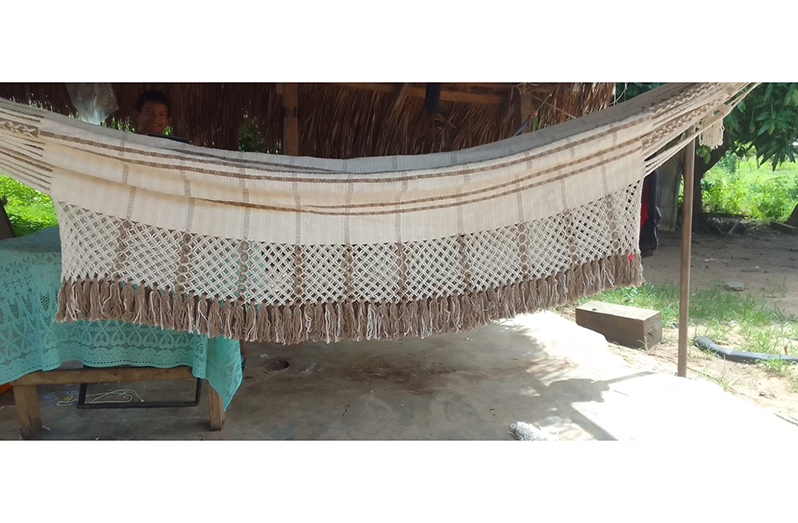AS Guyanese, we certainly know how to make ourselves comfortable utilising simple things to make our lives a bit more enjoyable such as the hammock. In fact, many may argue that one of the greatest feelings of comfort is relaxing in a proper hammock.
Joan Benedict of Region Nine (Upper Takutu-Upper Essequibo) produces premium quality cotton hammocks.
Benedict is one of the few persons locally who produces hand-made cotton hammocks from scratch after sourcing the cotton from the local cotton farmers in the Rupununi.
She is a native of St. Ignatius, a village on the outskirts of Lethem and she resides next door to Joan’s Craft Shop, a small establishment that her aunt operates.
Bendict is from a family of art and craft makers. Her mother used to make cotton craft, which was passed down to her and today, she has passed on the skill to her two eldest daughters.
The 45-year-old told the Pepperpot Magazine that she is the mother of five and her sole income comes from art and craft production, including the cotton hammocks which are sold for $12,000 each.
She reported that the process of making a cotton hammock takes two weeks and is long and tedious. In addition, it requires skills and creativity to produce the final product.
Benedict stated that as a girl, her mother taught her to make cotton hammocks and other art and craft forms, and she made a living from it in adulthood.
The art and craft producer said hand-made craft requires patience and expertise, is a long process, and is not a money-making job.
For this year, Benedict said she had one order for a cotton hammock, and when she finished making it, the customer no longer wanted the product.

That is one of the many challenges faced as a self-employed art and craft maker.
The mother of five disclosed that her husband passed away two months ago and it is difficult as a single parent.
But fortunately, her three eldest offspring, ages 25, 22 and 18 respectively, are employed and they have been assisting her in the home to meet daily expenses.
Benedict told the Pepperpot Magazine that the two others are ages 12 and eight and are attending school but have all been exposed to art and craft making.
“Art and craft are a family tradition, passed down from generation to generation and to keep the process alive, I also passed it onto my own children and I am sure they will hand it down to their own children,” she said.
Benedict stated that the art and craft talent came from her mother’s side of the family and luckily, she was able to grasp a lot over the years.
In addition, she related that she also makes cotton clothing in the form of skirts, tops, head bands, foot bands and bras, all traditional Amerindian clothes, and jewellery such as necklaces, hand bands and headdresses.
Benedict reported that she would get sales based on orders received, and sometimes she would journey to the city, at the Ministry of Amerindian Affairs, to display and sell her products or annually during September, which is Amerindian Heritage Month, she would visit to be a part of the exhibition at Sophia Exhibition Centre, Sophia.
She explained that sometimes, people would visit her home to make purchases.
The St. Ignatius resident added that she would also make cotton-based bedsheets, pillowcases and placemats.
Benedict stated that orders are delivered via minibuses or aeroplanes from St. Ignatius depending on how swiftly the customer needs the products.
She revealed that cotton is sourced from local cotton farmers in the Rupununi to be used to make all her hand-made signature art and craft, including the hammocks that last years and are durable despite Guyana’s tropical weather conditions.
Cotton is a natural fibre that is soft and breathable. It is comfortable to lie in or wear even in humid conditions, as we experience here in Guyana.
Cotton is also absorbent, so it keeps you cool even during rainy or hot weather. Cotton hammocks are usually more expensive than nylon hammocks owing to their durability and quality.



.jpg)











